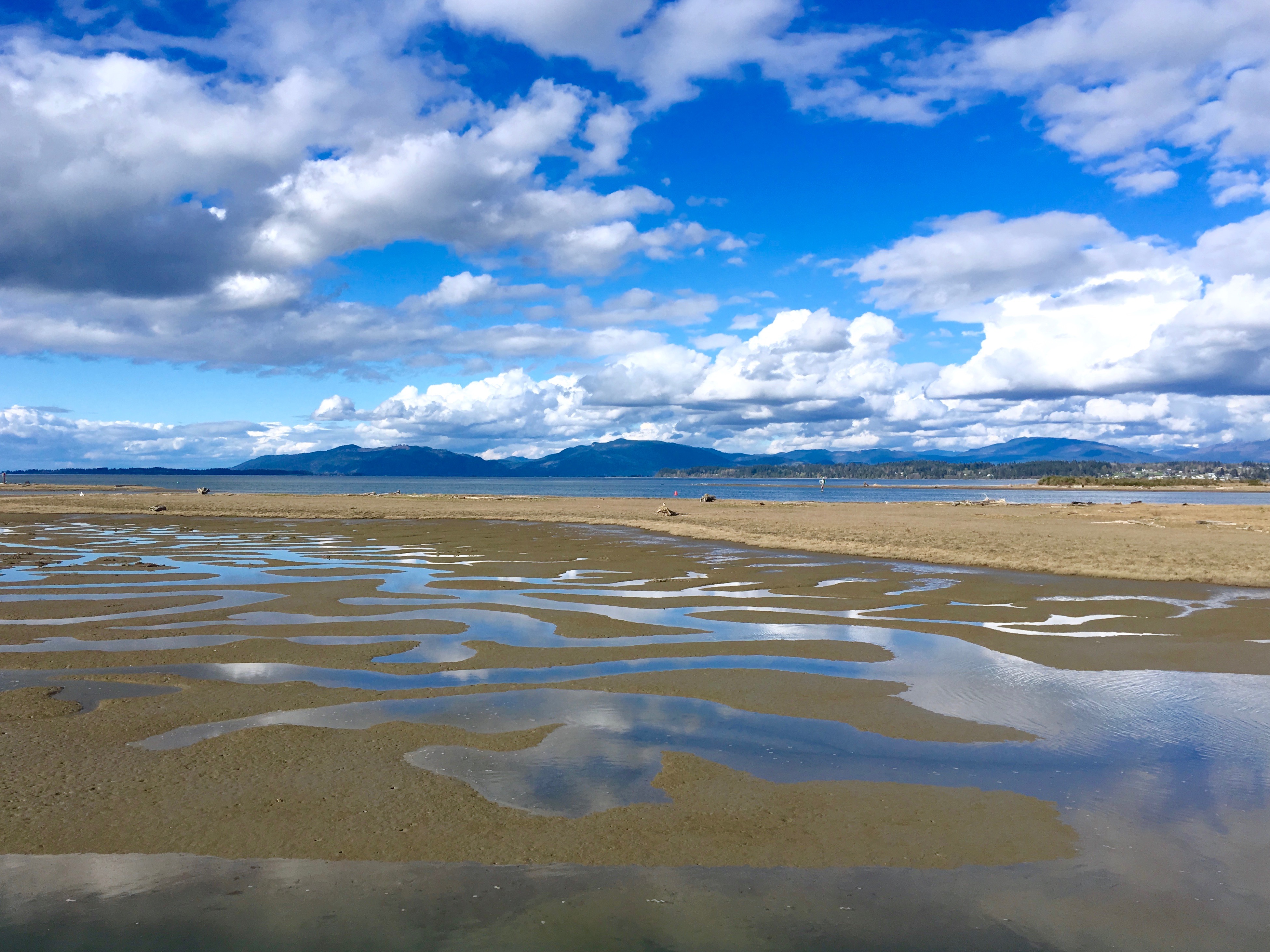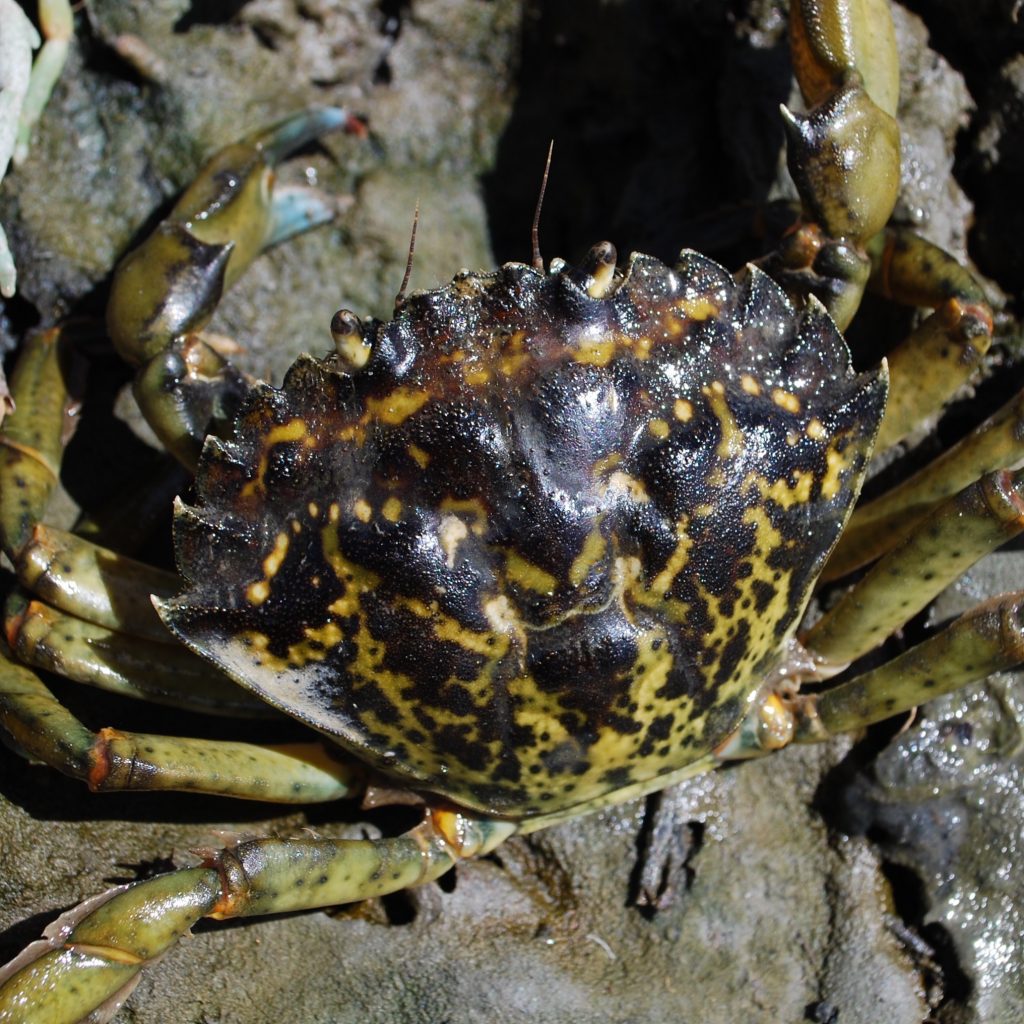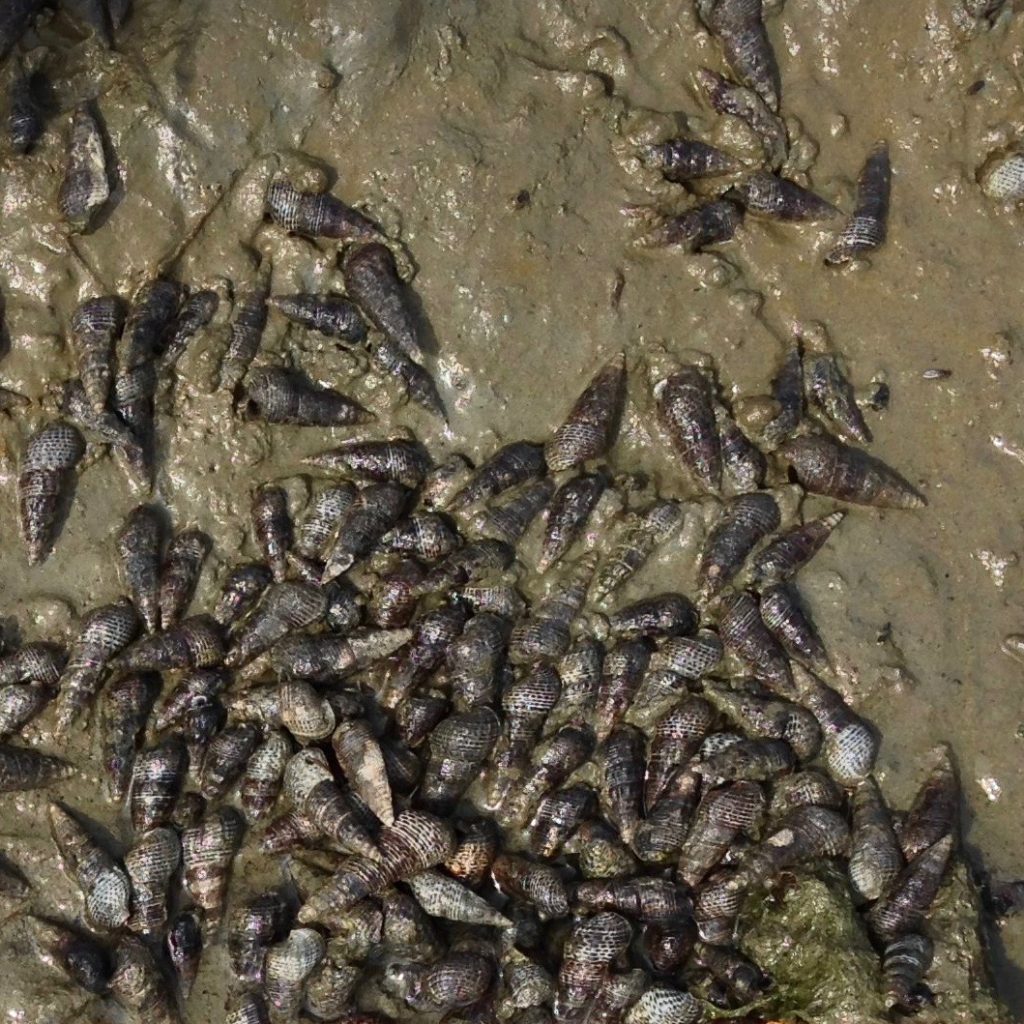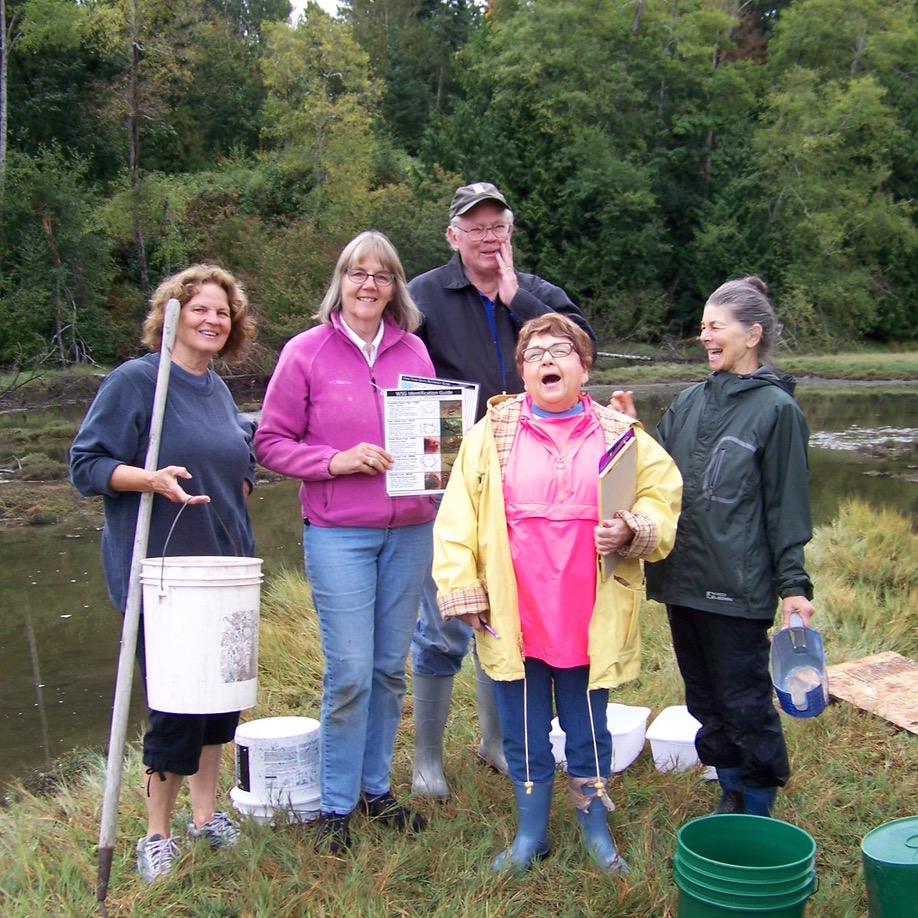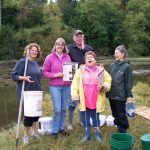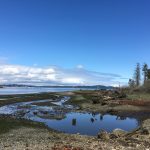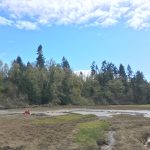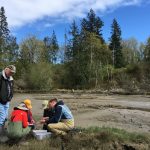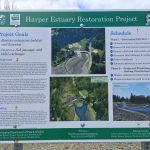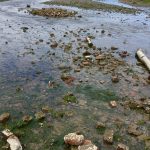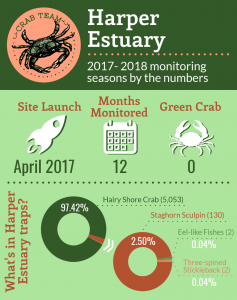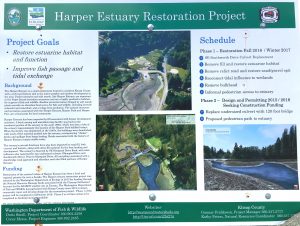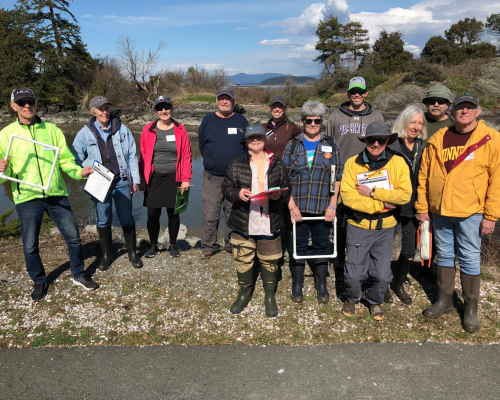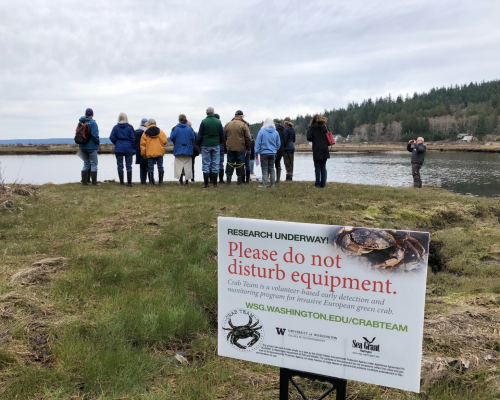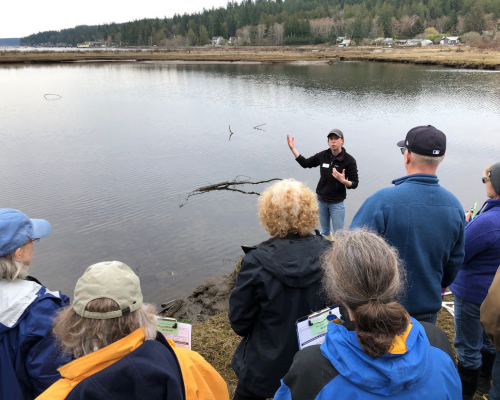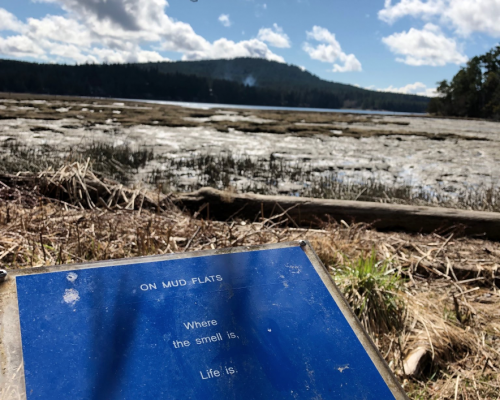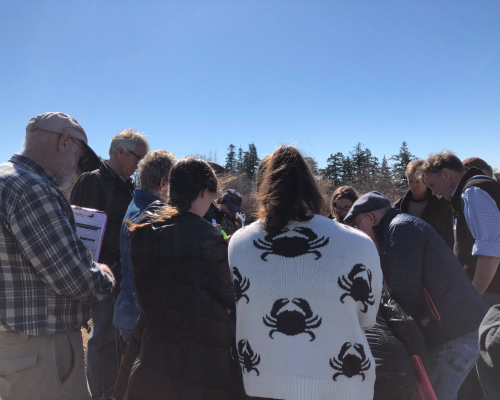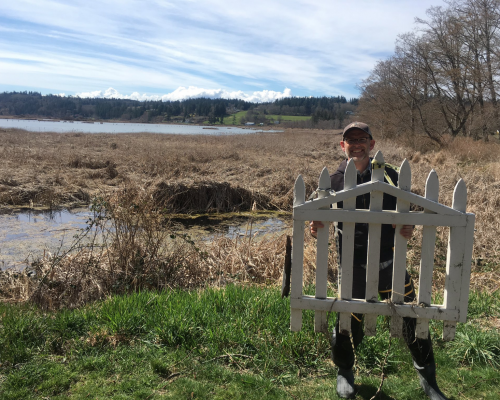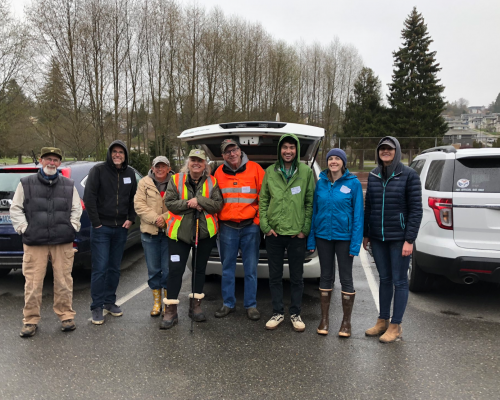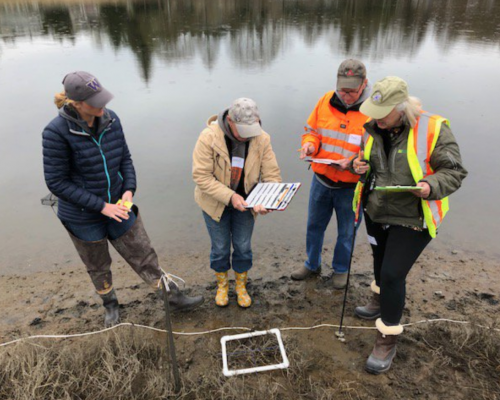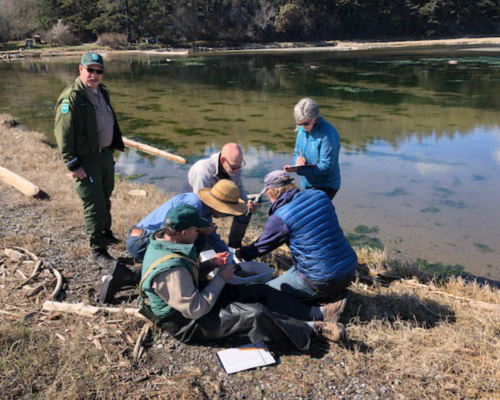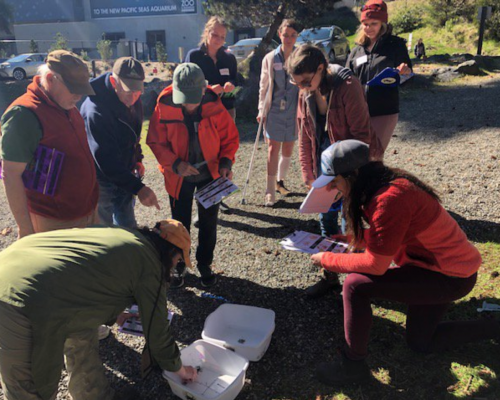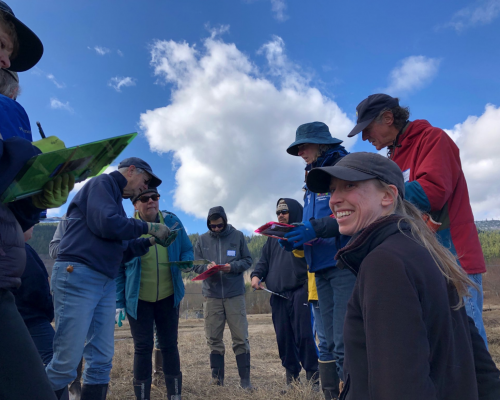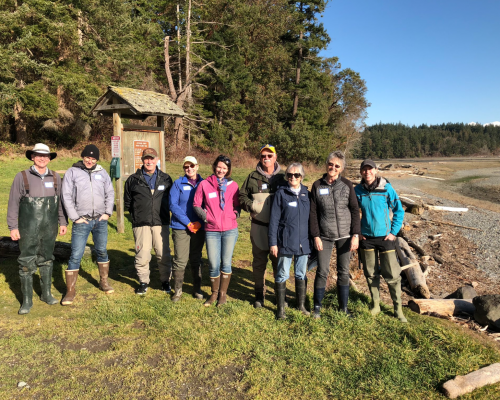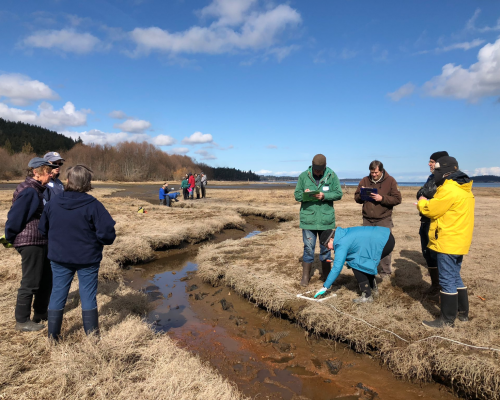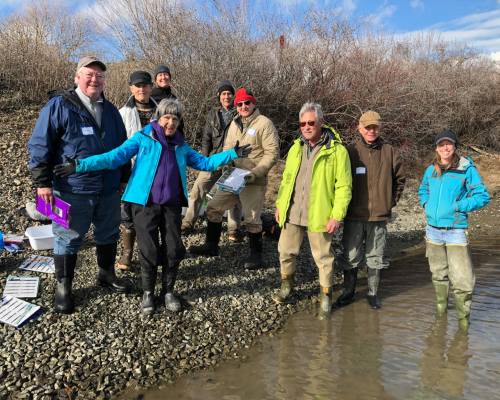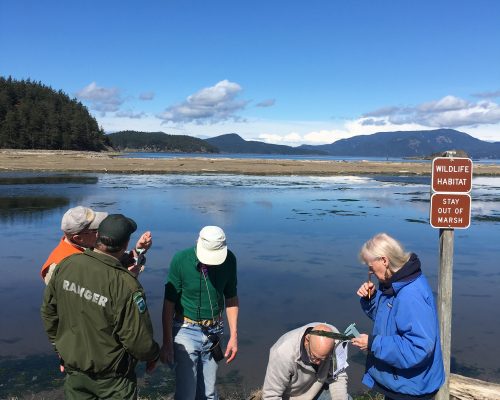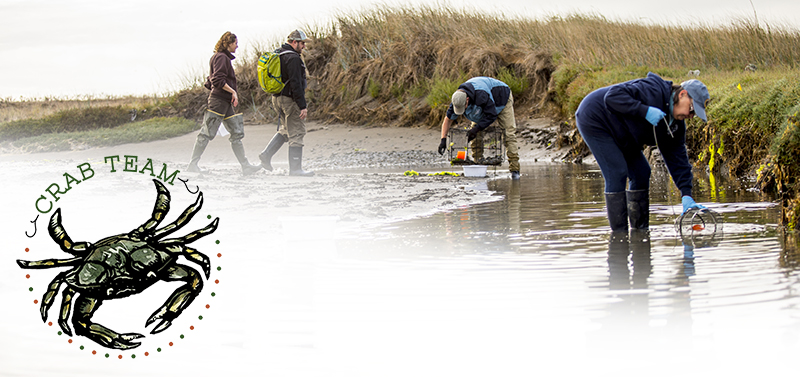
The “Team” in Crab Team
June 3, 2019
It’s difficult to believe, but Washington Sea Grant Crab Team has officially launched our fifth year of monitoring. It’s easy for us to reflect on the number of green crab, monitoring sites and traps we’ve set, and feel pretty good about what we’ve been able to accomplish. But we’re even prouder of the network of collaborators that has bloomed since Crab Team’s first traps hit the water.
Volunteers are at the core of this, because there is no way a program could cover as much ground without their contributions. We also partner with biologists from tribes and state agencies who contribute their valuable on-the-ground time and experience to looking for green crab, both as part of Crab Team monitoring and when they are out doing other surveying.
And, because green crab don’t stop at the border, neither do our partnerships. We continue to work with Washington Department of Fish and Wildlife and Canadian managers at Fisheries and Oceans, with support from the Puget Sound Partnership, to build a transboundary action plan that guides management for the entire Salish Sea.
A new story map by Encyclopedia of Puget Sound and Crab Team highlights the partnerships that underly green crab management. (click image to open story map)
The groundswell of support for Crab Team and the green crab management effort was critical to the recent inclusion of the program in the UW portion of the state budget, which funds the continuation of the program for the next two fiscal years. This secure funding is a huge step toward sustainability for Crab Team, and will enable us to work toward learning even more about green crab by partnering with researchers and managers to try trapping strategies and investigate the origins and impacts of green crab in the Salish Sea.
Facing an invasive species with the reputation green crab have as a global invader can be daunting. We feel privileged to do this work among friends, neighbors, managers and scientists who share their time, talent and passion for knowledge and conservation of Washington’s Salish Sea.
All our pinchy best,
Crab Team HQ
Fast Food: Some green crab are bigger, stronger, and hungrier than others
Guest columnist Brett Howard received her doctorate from Simon Fraser University, completing her dissertation research on the impacts of European green crab in British Columbia. You can read the published research underlying this article online for free.
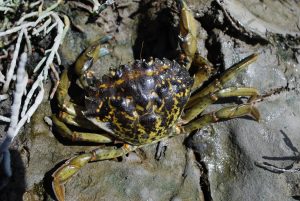
European green crab. Photo credit: Kelly Martin/WSG
The classic dramatic predation sequence in any nature documentary, where the predator is first shown stalking its prey, followed by a chase and attack, demonstrates the universal steps that all predators, from the largest charismatic megafauna to the smallest invertebrates, use to acquire food. In addition to being a spectacular visual, this familiar sequence also offers important ecological insight into predatory behavior.
In the late 1950s, a Canadian entomologist named Buzz Holling developed a mathematical model for predicting the success of a predator by breaking down every predation event into two components: the attack rate and the handling time. The attack rate measures how quickly a predator can find and attack its prey while handling time describes the time needed to capture and consume prey. A fast handling time prevents bigger, more aggressive animals from stealing prey, and also allows a predator to begin searching for its next meal sooner. By breaking the predation process down into these two measurable steps, it is possible to compare the efficiency of predators among individuals, populations or species.
This comparative approach is especially interesting when applied to invasion ecology, because knowing how effective an invasive predator is can offer insight into their long-term impacts on native prey populations. There have been a number of such studies that have demonstrated that invasive predators can outperform native predators. For example, the highly invasive largemouth bass (Micropterus salmoides) in South Africa can eat more prey, faster than a similar native fish, the Cape kurper (Sandelia capensis), which is consistent with its impacts on South African freshwater ecosystems (read the research in Alexander et al. 2014).
If functional responses can help explain behavioral differences between native and invasive predators, what could they tell us about differences in the predatory behavior of a single invasive species with multiple invaded regions? To test this hypothesis, my collaborators and I ran functional response experiments on European green crab (Carcinus maenas), because it is an invasive predator found in multiple invaded regions worldwide (Figure 1), and because these regions have all experienced very different occupancy histories and impacts of green crab. In North America, green crabs are known for having strong negative impacts on shellfish populations. Meanwhile, invasive green crabs in South Africa and parts of Australia have not had significant or detectable impacts. Why the impacts of green crab (and many other invaders) vary among invaded regions is not well understood, but is certainly affected by how an invasive species interacts with each region’s unique biotic and abiotic characteristics. In this study, we focused on how those differences manifest in the predatory behavior of green crab.
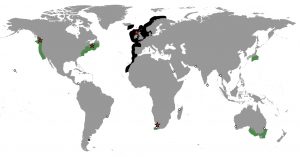
Figure 1: the native (black) and invasive (green) ranges of European green crab, and green crab collection sites for the study (star). Click to enlarge.
Between myself and my collaborators, who were working out of Queen’s University Belfast, in Northern Island, and Stellenbosch University in South Africa, we collected green crab from both the native range (Europe) and from three invasive ranges – in this case British Columbia, Nova Scotia and South Africa (Figure 1) – and performed functional response experiments by letting our crabs forage on different densities of mussels (Mytilus spp.) inside experimental chambers (i.e., Rubbermaid storage bins). Based on how many mussels each crab consumed (Figure 2 in the paper), we were able to estimate how effective green crabs from around the world were at detecting and attacking prey (attack rate) and how quickly they consumed that prey (handling time) (Read the research in: Howard et al. 2018).
Although our crabs were foraging for a sessile (attached) prey species in a relatively small area, we nonetheless detected differences in attack rate, which mean that some populations of green crab were faster at finding mussels than others. Green crabs from British Columbia were the fastest, possibly because they were more active in the experimental chamber and consequently came across more mussels (Figure 3).
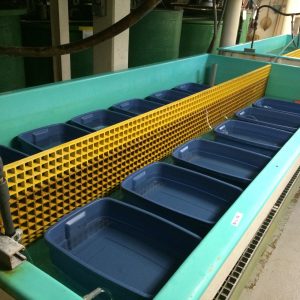
The lab setting for Howard’s experiment in British Columbia.
However, the most dramatic result was in the crabs’ handling times. North American invasive green crab, from both British Columbia and Nova Scotia, had much faster handling times than either the native green crab from Europe or the invasive crab from South Africa (Figure 3 in the paper). Rather than transporting live, non-native mussels internationally, we opted to use different, locally abundant mussel species in each of our four regions (e.g., M. trossulus in British Columbia). Despite the variation this may have introduced to the experiment, we consistently found the fastest handling times in North American green crab. Like other crabs, handling time for green crab includes the time it takes to break the shell and excavate the meat within. The ability to do this is dictated by how big (and therefore strong) the crab’s claws are compared to the prey’s shell thickness. An excellent example of this is our native red rock crab (Cancer productus), which is an important predator in mussel beds and has impressively large, powerful claws for this purpose. Green crab fall into both camps because they are heterochelous, meaning their claws are always different sizes – a smaller one for cutting apart soft tissues and a larger one for crushing shells (read the previous newsletter article on green crab claws). Being equipped with two different tools helps make green crab a successful invasive species, because they can adapt their diet to whatever prey happens to be available. It appears that green crab in British Columbia and Nova Scotia have improved on that advantage, as we found their crusher claws were significantly bigger than those of South African invasive green crab. Why North American green crab have such big claws is open to speculation, but it is well-documented that individual crabs can grow proportionally bigger claws over their life span in response to environmental cues (e.g., thick shelled prey or large-clawed competitors like red rock crab). Regardless of the reason, with bigger claws, green crab in North America can break into mussels quicker, giving them faster handling times.
There are two important take-aways from this study. The first is that there is still much to be learned about the predatory behaviors of invasive species by looking at their functional responses. The second take-away, specific to green crab, is that our findings qualitatively line up with observed predatory impacts for this species in the field. North American invasions of green crab can be quite detrimental, unlike in South Africa, and this could be attributable, in part, to the higher attack rates and faster handling times of North American green crab. From a management perspective, this study is further evidence that the shellfish populations in British Columbia, and probably throughout their North American range, are at risk of being over-exploited by these highly efficient invasive predators.
– Brett Howard
Species Name: Batillaria attramentaria
Common Name: Asian mud snail, Asian horn snail
Species Code: BAAT
Size: up to 45mm
Distinguishing Features: Snail with a long, narrow, conical shell. What you might imagine a unicorn horn to look like. Brown and black, sometimes with lighter stripes that are also visible along the inside of the apertural lip. Operculum circular with concentric rings.
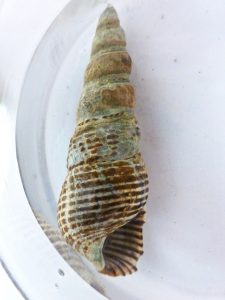
A Snail? Isn’t this CRAB Team?
Goal number one of Crab Team is finding populations of invasive European green crab while they are still very small. Thankfully, however, the traps that volunteers and monitors pull up every month are vastly dominated by native animals: staghorn sculpin, graceful crabs, three-spined stickleback, and, of course, the nearly ubiquitous hairy shore crab. Since 2015, Crab Team traps have captured nearly 225,000 animals, and only 10 of them have ever been European green crab – that’s less than 0.005 percent.
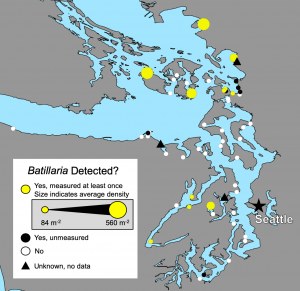
Map of Batillaria observations for all Crab Team sites. Circles indicate the site has been assessed for the presence of Batillaria, and they have either not been detected (black circles), have been detected but not measured (white circles), or have been detected and their density has been measured at least once (yellow circles, the size of which increases with average measured density). Presence of Batillaria has not been assessed formally at two sites (triangles). Click to enlarge.
One other invasive critter does make it into Crab Team’s top five, however. The Asian mud snail, Batillaria attramentaria, was the third-most abundant animal in traps during 2018. This might be a surprise, even to some Crab Team volunteers, because, though the top two species, hairy shore crab (91 percent) and staghorn sculpin (5 percent) are present at nearly every single Crab Team site, Batillaria was only detected in traps at 13 of the 54 sites (though, based on observation, we know they are present at at least 17 sites).
Batillaria is what ecologists refer to as “patchily distributed”, that is, it’s not found everywhere, but can be impressively numerous in some locations. As a graduate student, I studied this snail, and the highest density I measured was an average of about 2,550 snails in a square meter at one location in Padilla Bay, near Mt. Vernon. To understand how this snail can have such explosive abundance in some locations but be completely absent in other habitats that look essentially the same, it helps to know a bit of the Batillaria story in the Salish Sea.
This snail is one of a handful of invasive species that were accidentally imported as hitchhikers on Pacific oysters (Crassostrea gigas, read the research), which are themselves not native to the eastern Pacific Ocean, but were shipped from Asia to help replace the collapsed Olympia oyster (Ostrea lurida) fishery in the late 1800’s and early 1900’s. Before managers were aware of the dangers posed by non-native species, there weren’t many (or any) measures in place to reduce the chance of accidentally starting an invasion this way. Adult oysters, and all of the tiny things living on, under, and around them, were pulled up from reefs of Japan and Korea, shipped in crates and barrels across the ocean and dumped out into places like Samish Bay, just north of Padilla Bay. The best information we have estimates that Batillaria got to the Salish Sea by the 1920’s, which means we are coming up on the centennial of Batillaria’s addition to the flora of Washington’s inland waters.
Given that the snails can live up to six or so years, and produce thousands of eggs per year, it’s perhaps not surprising that that is enough time to build up extremely large densities in places like Padilla Bay. In fact, maybe the more curious question is:
Why don’t we see them absolutely everywhere?
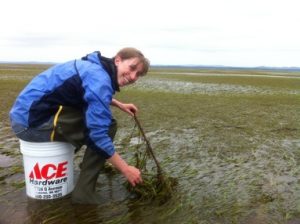
Five gallon buckets make great seats on the tide flats. Crab Team program manager Emily Grason checks on the status of tethered snails in a field experiment to assess how well Batillaria survive at Oysterville, Willapa Bay. (Photo courtesy of Ryan Davis).
The answer to this question has (at least) two parts. The first part has to do with the life cycle of the snail. Most marine snails, like our local periwinkles (Littorina spp.), attach their eggs to a stable or semi-stable part of their habitat, and then the young hatch out of their eggs into a free-swimming larva called a veliger. This has the advantage of enabling the young to get washed away from their parents and avoid competing with them for resources. Think of it as sending your kids to school in another state so you can regain control of your pantry. But this strategy has risks – the larvae, which don’t have a lot of control over where they end up, might land in a place that isn’t favorable for their survival. So some snail species take a different tack: they grow through their veliger stages while still inside the egg capsules and hatch out looking very much like tiny versions of their parents. This appears to be the case with Batillaria. The spread of a snail population with no dispersal stage is slower than it would be if the larvae could get washed around, and in the case of Batillaria, spread has been almost entirely human-aided. Batillaria was probably brought from the native range to the West Coast a number of times, but after arrival, the snail also got moved to new sites as humans moved oysters to try to find new places to grow them. This means that any place you see Batillaria, you are almost guaranteed that there is some history of growing oysters, most likely Pacific oysters, in that location. Nowadays, though, growers (and others) work hard to avoid moving anything other than the oysters and other shellfish themselves around as they work across multiple sites, so this type of introduction and spread is rare.
The other part of the answer is undoubtedly that not every place is suitable for Batillaria to thrive. One interesting case study of this is Willapa Bay, Washington. This coastal estuary in the very southwest corner of the state is one of the top oyster-producing estuaries in the world, with the majority of the harvest coming from Pacific oysters. Yet, as far as we can tell, Batillaria is only present in that estuary at one location in the entire bay – Oysterville. You can perhaps guess, based on that town’s name, what the history of Oysterville is, and why it might not be a surprise to find Batillaria there. What is a bit of a surprise is that the snail remains present, but only at very low densities compared to places like Padilla Bay.
To investigate why Batillaria do so well in Padilla Bay compared to Willapa Bay, I conducted an experiment to see how well snails survive in each place. How do you track snail survival out there in the big, wide world? You tie them up of course! Along with my advisor, Jennifer Ruesink, and a few extremely patient friends, I used fishing line and super glue to create 600 snail leashes, and tied them to rebar to answer the following questions about snail survival and how it compared between Padilla and Willapa Bay:
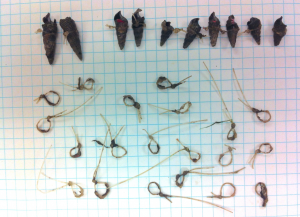
When you tie 30 Batillaria to a piece of rebar in Willapa Bay for 6 weeks, nearly all of them are eaten by crabs, as evidenced by their disappearance from their fishing line tethering loops. Even the remaining snails, top row, had been chipped at their openings by eager crabs. By contrast, no snails were ever consumed by crabs when the same experiment was conducted in Padilla Bay. (Photo: Emily Grason).
- Is anything eating snails at either site? If so, what?
- Do snails die “of natural causes” (such as drying out, or heat stress) at different rates at each site?
- Do snails living at different depths survive at different rates? Does this depend on which site they are living at?
The study clearly showed that snails very rarely died of natural causes at either site, but in Willapa Bay, where the density of Batillaria is atypically low, tethered snails got crunched up by crabs – primarily Dungeness and red rock crabs (read the research). Snails living deeper got hit especially hard, which makes sense because most of the larger crabs eating Batillaria live deeper than the snails do, and come up to eat them on high tides. By contrast, in Padilla Bay, none of these large crabs appear to spend much time at the depths at which Batillaria lives, enabling the snail population to grow much larger. Willapa Bay is known for having very robust populations of Dungeness crab in particular, and so, on a larger scale, this native crab probably has a role to play in keeping Batillaria rare in that estuary.
Is Batillaria that Bad[illaria]?
Does it matter whether Batillaria are absent or present, or if they are sparse or dense? That is, what impacts, if any, does this snail have – and if it’s so abundant, why aren’t we more concerned about it? Many managers only consider a non-native species to be “invasive” if it has impacts that negatively impact human economies. Batillaria, thankfully, does not appear to cause damaging impacts to oyster culture or native species that we are concerned about with other invasives, such as European green crab. But from the perspective of an ecologist, no matter how many there are, or what the type of impacts are, a non-native species, by virtue of having to eat something, and having to live somewhere, has an impact on the ecosystem it lives in. The snail eats benthic diatoms that grow on the surface of mud particles, not exactly the latest hot commodity in the commercial fisheries market! But how could the snail impact other organisms, and ecosystem processes, in our area? Researchers have observed a number of interactions and impacts with other species for Batillaria:
- In California, where Batillaria is also invasive, it outcompetes a native snail (Cerithidea californica) not found in Washington, to the extent that the native has disappeared at many sites where it used to be found (read the research).
- In Padilla Bay, Batillaria helps native hermit crabs by providing them an abundant sources of shells to live in (read the research).
- Also in Padilla Bay, Batillaria makes it possible for a large population of invasive slipper shell limpets (Crepidula fornicata) to live, because the shells of Batillaria provide a rare (in Padilla Bay) hard surface on which the limpets can live.
- Batillaria encourages the growth of the non native dwarf eelgrass (Zostera japonica) (read the research). The non-native eelgrass can, in turn, make it difficult to grow clams (read the research), but similar to the native eelgrass (Zostera marina), can also provide valuable habitat and resources for birds, fish and other animals (read the research).
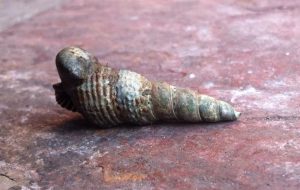
A Batillaria with a Crepidula limpet on its shell.
Certainly, ecologists have not discovered, or characterized, every impact Batillaria has with the local ecosystems, but even this short list offers an interesting example of how non-native species can be both helpful and harmful to native species, and can even help other non-native species succeed!
This snail is not currently considered a big enough threat to the Salish Sea to warrant any management, or even much study. But that’s not the same as saying it is “beneficial,” net neutral, or even that it poses no threat to native ecosystems. In many cases, non-native species aren’t initially a cause of concern in a new place … until they are. That is, new impacts can pop up even after a species has been found in a new place for quite a while. The changes might be because of a chance event disturbing the native ecosystem, and creating an opportunity for the non-native, or another introduced species that helps the original invader take off (read the research).
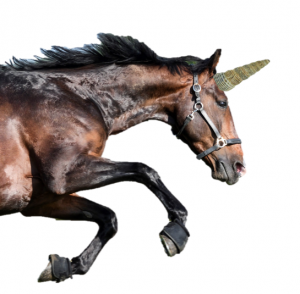
Some (mostly Emily) have likened the shape of this snail to a unicorn’s horn. That basically makes Batillaria magical.
Though the shape of this snail has been likened (by me, mostly) to a unicorn’s horn, it is nothing of a rarity in our neck of the woods. In fact, I surveyed, modeled and estimated the total number of Batillaria in Padilla Bay alone at 1.2 – 2.8 billion. In addition to Batillaria showing up in traps, extra-dedicated Crab Team volunteers at a few sites are helping to collect additional data on Batillaria (see map above), by counting how many of them they find on the shore at their sites, and seeing how this changes over time. These data could prove useful in trying to understand how invasions change over time or with the arrival of green crab. In the case of Batillaria, we’ve seen that numbers in our region appear to have stayed consistent, but at least one site in California has seen a population collapse for Batillaria – the cause of which is as yet unknown – after decades of abundance.
Cases of extreme abundance, like that of Batillaria, can offer a way to learn about how and why certain invasive species flourish while some never manage to take hold. Hopefully future research will continue to shed light on not only this snail, but on invasive species generally, and help us manage them more effectively.
–Emily Grason
The Harper Estuary is a hospitable home for hairy shore crabs and a slicky, sticky, stucky place for footwear. The Harper HEOR hunters and their beloved estuary have a special history, a committed community and hope for future restoration.
Suquamish villages were once located to the northeast of the Harper Estuary on Blake Island to the west of Harper, at the area now called Colby. With calm waters, good habitat and a small stream in close proximity to the villages, the Harper Estuary was bound to have played a role in hunting and fishing and foraging. Even today, winter ducks abound, and you can find silver cinquefoil, once cultivated by Salish Tribes to promote growth of the edible roots, among the saltmarsh vegetation. The estuary likely served as great nursery habitat for juvenile salmon, and the stream continues to support coastal cutthroat (Oncorhynchus clarkii).
Once the area was occupied and developed by European settlers, however, roads and buildings began to alter the shape and function of the estuary. Most significant of the occupants of Harper’s shores was a regionally important brick-making factory. In the late 1800’s, the Harper Clay Products Company started making bricks, taking advantage of the clay-rich hillside nearby and of relatively easy water access to Central Puget Sound. The factory was built on the western shore of the estuary with barge loading infrastructure built into the estuary. You can see some great old photos and maps in a Yukon Harbor Historical Society blog post and from the pdf of a Cultural Resources Assessment presentation. You can still find some of the factory’s good bricks in buildings in Seattle’s historic Pioneer Square and in the Governor’s Mansion in Olympia. Gazillions of bad bricks, however, were dumped into the estuary, and additional bricks plunked into the water during barge loading. The brick provides some cobble-like habitat for sea life that live on hard surfaces, but it didn’t do any favors for the tideflat organisms that would have been there naturally and likely started to affect sediment movement in the estuary.
Harper Estuary’s modified fate was clinched when Olympiad Drive was built in 1939. This left only a small culvert between the upper estuary and Puget Sound, limiting the movement of water, fish,
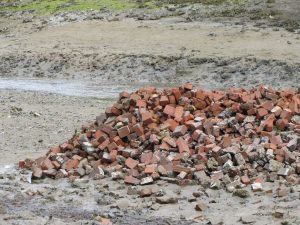
A pile of discarded Harper bricks on the beach. Most of the pile and its ilk were removed during the late 2016 restoration work, but many a brick can still be discovered for those who wish to claim a piece of history (and get garbage off the beach).
invertebrates and flotsam and jetsam to and from the upper estuary. In combination with an even older road along a sand berm, Olympiad also isolated the northeast portion of the estuary, which later developed into a freshwater marsh. The Puget Sound side of Olympiad Drive was even filled (using no small share of brick bits) and used as a local boat launch during high tide.
The quality clay of the area and restricted flow likely play into the estuary’s epic mud. Stepping off the vegetated areas come with significant risk of boot loss, face planting, and requires continuous concentration (walk on toes, keep moving, walk on toes, keep moving, …). In site captain emeritus Jim Heytvelt’s words, “MUD, Boot Sucking Mud! Not your ordinary seashore estuary mud but fine Harper Clay mud. This has to be the slickest mud about.”
In addition to industry, Harper developed into a residential community and was an important transportation hub, with the nearby pier serving ferry traffic to and from Vashon Island and West Seattle until the 1960’s.
Harper Present(ish)
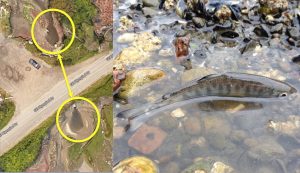
Harper’s plunge pools and a coho salmon smolt that was among many languishing in the downstream pool one day.
Undersized culverts aren’t cool in salmon country. Plunge pools at either end of the culverts become a temperature and predation hazard for salmon stuck at low tide and may limit movement up or downstream. Wood, sediment, wrack and other important materials for habitat and food webs can no longer easily move in and out of the estuary with the tides, and it’s a lot harder for a crabs, fish and other species to follow the flow to a saltmarsh smorgasbord.
In addition to the culvert conundrum, the area of Harper that became a freshwater marsh, while it may have had a whole new set of functions, had lost its ability to support migrating fish and the backshore and saltmarsh plants and animals that once occupied it.
What to do? Kitsap County has been working with the Washington Department of Fish and Wildlife with funding support through the Washington Department of Ecology to remove fill, culverts, bulkheads and road beds and to provide recreational access to the area. The first phase of the project achieved many of the restoration goals, including replacing an undersized culvert at the upstream end of the estuary, establishing a tidal connection to the freshwater marsh and removing a bulkhead and a lot of fill. The most expensive, and likely highest impact, part of the project, replacing the Olympiad Drive culvert with a bridge, has been planned but awaits funding.
Meanwhile, the Harper and research communities have not been idle. Jenise Bauman and students from Western Washington University started collecting data on the salt marsh soils and vegetation in 2016, while in 2017 community members joined Washington Sea Grant’s Crab Team to establish a monitoring site in the upper estuary.
During the first two seasons, the Harper Crab Team has counted 5,000 hairy shore crabs and landed a handful of fish. Jim Heytvelt expressed the sentiments of other team members, “How many ways can you spell HEOR? We would get excited to see a sculpin or stickleback.” While diversity is low, Harper is an excellent example of the importance of Crab Team data beyond just looking for green crab.
Without the efforts of the Harper Crab Team and teams at the other 50+ Crab Team sites, our understanding of the mobile critters in these estuaries would be limited in volume and scope, if data would even exist. There would be little evidence of change (or lack thereof) after restoration and no ability to compare with similar locales and answer questions like: Will there be more species moving in with the tide? If there are changes in the community, will they happen immediately or over time?
Harper Future
Particularly with the breach of the freshwater marsh, Harper is already experiencing significant changes, even as we await funding decisions to reestablish unimpeded flow into the upper estuary. Thanks to support from Kitsap County, through the Department of Ecology, Jenise Bauman’s work on vegetation and soils will be expanded in 2019, and UW partners will look at shoreline organisms and habitat. Crab Team Program Assistant Kelly Martin will lead members of the Harper Team and others in shorter term, expanded trapping and molt surveys in the newly restored marsh and downstream and upstream of the culvert. In addition to the data regularly collected by the Harper Crab Team, this extra information will give a better picture of how the estuary community changes over time with restoration.
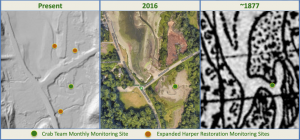
Visit Harper some time as a Crab Team Tourist or just stop by to enjoy the wildlife, dive the pier, reflect on history and our shoreline fingerprint, paddle, explore the beach and enjoy the views of Central Puget Sound. Your even have a good chance of stumbling upon a member or two of this community Crab Team, just out for a neighborhood stroll.
-Jeff Adams
Photo Gallery
We love to get the virtual experience of monitoring with all of the Crab Team volunteers. Do you have a photo to share? Send it to crabteam@uw.edu. (Click on arrows to scroll, and photos to enlarge for more detail.)
